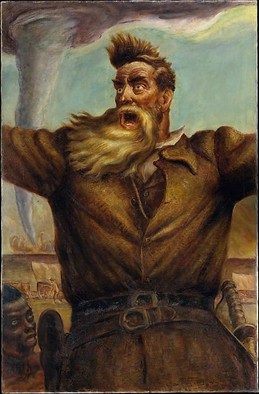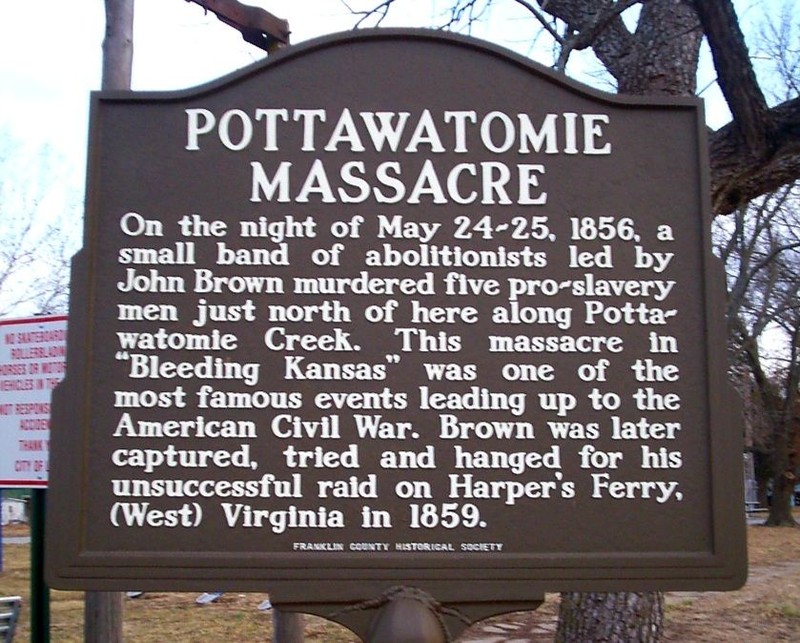Pottawatomie Creek Massacre Historical Marker
Introduction
Text-to-speech Audio
This state historical marker recalls a brief version of an infamous attack on pro-slavery men that occurred near this location. On the night of May 24-25, 1856, John Brown, three of his sons, and two other associates attacked, mutilated, and killed five pro-slavery men on the banks of the Pottawatomie Creek. This site at Pottawatomie Creek is important to understanding the trajectory of John Brown's life. Brown and his associates justified their attack as retaliation for the deadly actions of a pro-slavery mob that attacked, burned, and destroyed property throughout Lawrence, Kansas, just days earlier. This act of retaliation led to additional outbreaks of violence and small skirmishes between the pro and anti-slavery groups throughout Kansas and parts of Missouri, known at this time as "Bleeding Kansas." Free-State Kansans fought for their right to be a free state, showing the rest of the country strength and determination to aid the national fight to rid the country of slavery. John Brown's role in this fight, while violent, demonstrates his trajectory in his followers' willingness to use violent means to fight against slavery.
Images
Portrait of John Brown by Ole Peter Hansen Balling in 1872

"Tragic Prelude" depicting John Brown located in the Topeka capitol (John Steuart Curry 1939)

Marker for the Pottawatomie Massacre located in Lane, Kansas

Backstory and Context
Text-to-speech Audio
John Brown was a well-traveled man who held many different job positions throughout his life. He was a farmer, businessman, real estate strategist, and above all a man of God. Brown eventually ended up coming to the Kansas territory, more specifically, Osage county in 1855. He was known by those around him for being a deeply religious man with an iron will that others found striking. He was also a very strongly, self-proclaimed anti-slavery man.
Brown’s anti-slavery beliefs, fuelled by his eccentric opinion and understanding of justice through religion, were eventually what caused him to act in such a violent manner in reaction to the sacking of Lawrence. The attack, burning, and ransacking that occurred in Lawrence happened three days before Brown's retaliation at Pottawatomie Creek. Five pro-slavery men, who were not necessarily connected to the sacking of Lawrence, were in their cabins along the Pottawatomie Creek on the night of May 24. Brown, three of his sons, and two other anti-slavery men broke into their homes and dragged them out. Brown and his associates proceeded to brutally beat and mutilate the five men, scattering their body parts along the banks of the creek. Then, Brown and his accomplices escaped into the night. Brown, who was now a fugitive of the law, traveled North to receive asylum from other abolitionists.
Just as Brown and his followers were enraged about the sacking of Lawrence, the pro-slavery South was now equally enraged about the attack at Pottawatomie Creek. A wave of retaliation, guerilla warfare, and violence was set off not only between the rivals of Kansas and Missouri but across the country. The violence and retaliation that occurred in Kansas between the pro and anti-slavery men caused copious amounts of blood to spill on both sides leaving 200 dead and multiple millions of property damage in its wake. Thus, the term ‘Bleeding Kansas’ was born stemming in almost totality from Brown’s act of brutal violence on the fateful night of May 24, 1856, and the retaliation that followed in its wake.
Brown and his string of violent behavior to abolish slavery did not end after his attacks at Pottawatomie Creek, but after his multiple other violent offenses including his raid of a weapons arsenal in hopes to incite a slave rebellion at Harpers Ferry, Brown went to trial. After his trial, he was convicted of numerous counts of first-degree murder, insurrection, and treason. Brown was eventually hung on December 2, 1859. His last words before he faced the gallows were, “I John Brown am now quite certain that the crimes of this guilty land: will never be purged away; but with Blood. I had as I now think: vainly flattered myself that without very much bloodshed; it might be done”.
Brown was considered in many senses a “religious fanatic” with a dangerous taste for justice that he sought to achieve through violence. His consistent pattern of violence caused many to question if his means justified the noble cause of abolishing slavery that he was fighting for. There is much to debate regarding John Brown's character; however, it cannot be questioned that the site of the Pottawatomie Massacre is historic for not only Kansas but for the nation and its history of the fight against slavery. The massacre at Pottawatomie Creek stands as a marker for the series of events and the blood that was shed in the succession of this massacre that allowed many to fight for a cause that changed our nation forever.
Sources
Brown, J. S. (2006). Bleeding kansas at 150. Army, 56(5), 86-87. Retrieved from https://www2.lib.ku.edu/login?url=https://www.proquest.com/trade-journals/bleeding-kansas-at-150/docview/237086382/se-2
Brown, John. Letter from John Brown to his Children. Kenneth Spencer Research Library. 11 Aug. 1856. https://blogs.lib.ku.edu/spencer/happy-birthday-john-brown/ . Accessed 11 Oct. 2022.
Bell, Fraser. "God's terrible avenger: John Brown and liberty." Queen's Quarterly, vol. 112, no. 3, fall 2005, pp. 340+. Gale Academic OneFile, link.gale.com/apps/doc/A139345949/AONE?u=ksstate_ukans&sid=summon&xid=7a4593d8. Accessed 24 Oct. 2022.
ushistory.org. The Pottawatomie Creek Massacre, Accessed October 18th, 2022. https://www.ushistory.org/us/31d.asp.
The Life, Trial, and Execution of Capt. John Brown. New York. Robert M. De Witt.
https://www.metmuseum.org/art/collection/search/488649
https://civilwartalk.com/threads/pottawatomie-creek-massacre.176233/
